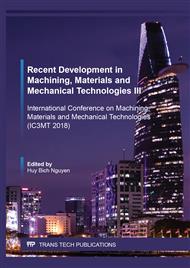p.71
p.77
p.84
p.92
p.99
p.106
p.114
p.123
p.129
Effect of Amorphous Silicon Carbide Interlayer on Diamond-Like Carbon Film Structure and Film Hardness
Abstract:
This study was performed to improve the adhesiveness of a diamond-like carbon (DLC, a-C:H) layer film with an a-SiC interlayer. In previous studies, an a-SiC/DLC layer film was formed and changes in the DLC film structure and hardness caused by the thickness of the a-SiC layer were examined. After the a-SiC interlayer thickness increased and the G-peak position shifted to a lower frequency, the peak began shifting to higher frequencies. The G-peak position reached a minimum frequency at a film thickness of approximately 0.3 μm. In contrast, as the thickness of the a-SiC interlayer increased, the FWHM of the G-peak position increased almost monotonically and the number of sp3 bonds also increased. As the interlayer thickness increased, the hydrogen content in the DLC film increased, and then began decreasing, with the interlayer film thickness exhibiting a local maximum at approximately 0.3 μm. As for the DLC film hardness, a correlation between the hydrogen content and half width of the G-peak position was observed. When the hydrogen content was ≤40 at%, a positive correlation with the FWHM (G) was observed, and when the hydrogen content was 40 at% or above, a negative correlation with FWHM (G) was found. The adhesiveness of the DLC film and substrate was improved by forming an a-SiC thin film as an interlayer. The effects of the a-SiC thin film on DLC film quality were determined.
Info:
Periodical:
Pages:
99-105
Citation:
Online since:
October 2019
Price:
Сopyright:
© 2019 Trans Tech Publications Ltd. All Rights Reserved
Share:
Citation:


